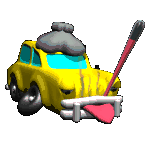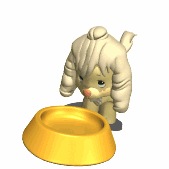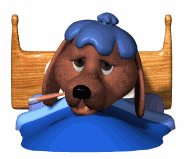
Starting Out:
Your puppy has just entered a whole new world. Sights, sounds, smells, people... all are new to him. Allow him to explore his new surroundings with as little restriction as possible. Treat him with "kid gloves", talk softly, move slowly, cuddle and play with him. All of this will help him learn that he is home.

Car Sickness:
Car sickness is common among puppies. It is a good idea to bring paper towels just in case. Holding the puppy in your lap may help him feel more secure and help prevent car sickness. Car sickness generally decreases with age and more frequent car trips.

Feeding and Potty Training Your Puppy:
The first rule in feeding your puppy is to chose a good quality dog food. Most major name brand feeds use good quality ingredients and are a wise choice. Off brand feeds, those named for the store that sells them or unknown companies products may have the same type of ingredients but the quality will be less. In other words you get what you pay for.
There are two ways to go about feeding your puppy. One it to "free feed" which means food is always available to him. The other is to use a feeding schedule, breaking his daily amount into several different feedings. Choose the feeding option that best fits your schedule.
For people who stay at home and want to potty train their puppy the best choice is a feeding schedule. Take your puppy outside 15 minutes after each of his 3 or 4 daily feedings. Eventually this will become a learned habit and he will want to go outside regularly. As he grows older he will only require feeding once a day but will already understand that his potty place is outside. (Or on the paper if you go that route). For paper training we recommend "Wee-wee pads". Placing him on the pad after each feeding. Once he's used to the pad you can make a slow conversion to paper by first covering the pad with the paper and eventually using paper only. It is a wise idea to make the puppy's last meal in the early evening to prevent any night time accidents. Also if your puppy gulps his food when you feed it (sometimes making himself sick) he's probably not getting enough food or not getting it often enough, making him think he has to hurry or it won't be there.
For free feeding simply leave the puppy's food in an area readily available to him. If you find your puppy seems over weight cut back on the amount of food given each day. It is still a wise idea to take up the puppy's food in the early evening to avoid a night time accident.
Puppies digestive systems were not designed for "people food". There are plenty of snacks and treats available to purchase that will make him happy and not hurt him in any way. There are two major no-no's milk and chocolate. Both of these will not only make your puppy sick but can kill him. Click here to learn more about Potty Training!

Hypoglycemia:
-
Definition: Hypoglycemia is low blood sugar .
-
Physiology: Glucose is the main source of energy for the body and the only source of energy for the brain. When most of the glucose in the blood is used up, the body responds by releasing glucose from the liver and by breaking down fatty acids and other energy sources. If no more stored glucose is available, the brain runs out of energy and can even be damaged beyond repair.
-
Causes: “Puppy Hypoglycemia” is seen in toy breed dogs less than 5 months of age. These dogs have more brain mass per body weight compared to other breeds and therefore need more glucose for brain function. A puppy that is not eating well is more prone to getting "down".
-
Signs: Weakness, loss of mental alertness, wobbliness, muscle twitching, seizures, and death.
-
Treatment: If the puppy is not eating well a little honey or corn syrup can be added to his food to help alleviate any drop in his blood sugar. Intravenous dextrose (a sugar) is needed for treatment of most severe cases. If the dog is having a seizure at home, the owner can try rubbing corn syrup on the gums while transporting to the hospital. Large amounts should not be fed unless the dog can swallow. Once seizures are controlled, blood work and other diagnostic tests should be performed to determine the cause of the problem.
CLICK HERE for more in-depth information about hypoglycemia.

Parvo:
-
Definition: A very common and very serious viral disease in dogs. The virus is officially known as Parvovirus. The disease caused by this virus is commonly referred to as "Parvo".
-
Physiology: Parvovirus affects puppies much more frequently than it affects adult dogs. The virus grows in rapidly dividing cells. The intestinal lining has the biggest concentration of rapidly dividing cells in a puppy's body. The virus attacks and kills these cells, causing diarrhea (often bloody), depression and suppression of white blood cells -- which come from another group of rapidly dividing cells. In very young puppies it can infect the heart muscle and lead to "sudden" death.
-
Causes: Canine parvovirus is carried by dogs. Adult dogs may be infected carriers without showing any clinical signs. Dogs with the typical diarrhea that parvovirus causes shed the virus as well. It can last a long time in the environment, perhaps as long as 9 months or longer.
Generally, it takes 5-10 days from the time of exposure for dogs and puppies to start showing symptoms and to test positive for parvo. Parvo is highly contagious to unprotected dogs. It is recommended that puppies receive a preventative shot at 6, 9, 12, and 15 weeks of age. Even puppies who have been vaccinated on a regular basis are not protected until they are at least 18 weeks old. Parvovirus can remain infectious in ground contaminated with fecal material for five months or more if conditions are favorable. Extremely hardy, most disinfectants cannot kill the virus, however chlorine bleach is the most effective and inexpensive agent that works, and is commonly used by veterinarians.
The ease with which infection with Parvo can occur in any unvaccinated dog must be stressed. The virus is extremely hardy in the environment. Withstanding wide temperature fluctuations and most cleaning agents. Parvo can be brought home to your dog on shoes, hands and even car tires. It can live for many months outside the animal. Any areas that are thought to be contaminated with parvo should be thoroughly washed with chlorine bleach diluted 1 ounce per quart of water. Dogs and puppies can contract parvo even if they never leave their yards. Parvo virus, despite what you might hear, is NOT an airborne virus. It is excreted in the feces of infected dogs, and if someone -- human, dog, bird, etc. -- steps in (or otherwise comes in contact with) the excrement, the possibility for contamination is great. Some people speculate that birds invading a dog's food dish can deposit the parvovirus there. If you think you may have come in contact with parvovirus, a strong solution of bleach and water does kill the virus, so you can wash your shoes and clothes, even your hands with it, to reduce the risk of infecting your dog. Rest assured that parvovirus is specific to dogs alone and cannot be transmitted to humans or other pets.
-
Signs: When dogs and puppies contract parvo, they often have diarrhea - usually bloody foul-smelling, vomiting and lethargy. Symptoms usually begin with a high fever, depression, and loss of appetite. In many cases, dehydration, shock, and death follow.
-
Treatment: The best form of treatment is prevention. DO NOT TAKE YOUR PUPPY TO HIGH TRAFFIC AREAS WHERE IT CAN INFECT OR BE INFECTED UNTIL IT HAS HAD ALL OF IT'S PUPPY SHOTS! By isolating your puppy you may be saving it's life!
Without intense treatment, the puppy will die of dehydration. Treatment generally consists of IV or subcutaneous fluids and antibiotics. There is no cure for Parvo. Veterinarians can only treat the symptoms aggressively, and try to keep the dog alive by preventing dehydration and loss of proteins. Because there is no cure for any virus, treatment for parvo is mostly that of supporting the different systems in the body during the course of the disease. This includes giving fluids, regulating electrolyte levels, controlling body temperature and in severe cases giving blood transfusions when necessary. Parvo strikes fast and without mercy.
hits since Jan 18